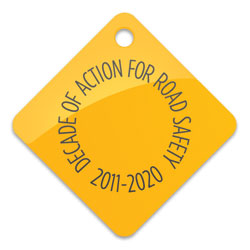Musculoskeletal societies support Decade of Action for Road Safety 2011-2020
More than 100 countries have teamed with the World Health Organization, the United Nations and EFORT to promote global road safety.
After years of supporting the Bone & Joint Decade, the European Federation of National Associations of Orthopaedics and Traumatology has now joined forces with the World Health Organization and United Nations for the 2011-2020 Decade of Action for Road Safety.
The worldwide initiative was launched May 11, 2011 with a yellow traffic tag announcing the decade’s start displayed at such major world landmarks as New York City’s Times Square, Rio de Janeiro’s Christ the Redeemer statue, Sydney’s Harbour Bridge, London’s Trafalgar Square and Geneva’s Jet d’Eau fountain.
“People around the globe die more of road traffic accidents than they do of malaria, tuberculosis and HIV combined, so it really is a big deal,” Pierre Hoffmeyer, MD, president of the European Federation of National Associations of Orthopaedics and Traumatology (EFORT), told Orthopaedics Today Europe.
Pillars of road safety
|
|
The World Health Organization (WHO) estimates 1.27 million people die each year from road-related trauma and more than 50 million people are injured. Left unchecked, the number of casualties would increase to 1.9 million lives in 2020. The international community hopes to save 5 million lives by the year 2020 through the initiative by supporting countries to legislate more effectively on factors such as motorcycle helmets, child safety restraints, speeding, seat belts and drinking and driving, according to the WHO website.
In its 2009 Global Status Report on Road Safety, the WHO reported more than 90% of fatal traffic collisions happen in low- and middle-income countries containing half of the world’s vehicles. According to the report, road traffic injuries were among the top three causes of death for people between 5 years and 44 years old.
|
Image: World Health Organization |
The five pillars of the decade, according to the Global Plan for the Decade of Action for Road Safety 2011-2020, are focused on investing in safer roads, increasing road safety management, developing safer vehicles, encouraging safer road use and improving post-crash response. The final pillar is where orthopaedic surgeons and organizations like EFORT are involved, said Hoffmeyer, who is professor of orthopaedics and chairman of the Department of Surgery at the University Hospital of Geneva and a member of the Orthopaedics Today Europe Editorial Board.
“Orthopaedic surgeons play a big role in this in the sense that most traffic accidents do occur in people who sustain fractures and the fractures are the things that will bother them in the long-term,” he said, adding that complications from traffic crashes, such as disability issues, could prove economically strenuous.
Trauma education
Another issue prevalent in the last 10 years to 15 years that organizations will focus on is the increased involvement of elderly people in traffic crashes.
“People are now living longer. They are active longer and so they get into trouble longer,” Hoffmeyer said. “We are seeing accident victims who are a lot more frail than a 30-year-old who gets in a car crash.”
Since many orthopaedic surgeons are not used to seeing this type of patient, during the next 10 years EFORT is working to educate them about trauma care, starting by inviting WHO members to a symposium on preventing road trauma to be held in May at the 13th EFORT Congress 2012 in Berlin, he said.
Etienne Krug, MD, MPH, Director of the WHO Department of Violence and Injury Prevention and Disability, said although the resolution for the Decade of Action was well-supported in the U.N. General Assembly, only 15% of countries currently have legislation regarding the key risks outlined in the Global Plan. The goal, he said, is to increase that number to 50%.
|
|
“The international community has only woken up to road safety about 10 years ago,” Krug told Orthopaedics Today Europe. “Little by little, the issue has gathered strength with the publishing of the World Report on Road Traffic Injury Prevention. So it took a while to realize the magnitude and far-reaching impact of the lack of safety on our roads and then the need to take action.”
Joint trauma prevention
In addition to EFORT, as of press time, other musculoskeletal organizations that support the decade include the International Society of Orthopaedic Surgery and Traumatology; EuroSpine — The Spine Society of Europe; Fragility Fracture Network; Bone & Joint Decade; European Paediatric Orthopaedic Society, and AO Foundation.
In April, a discussion is scheduled to take place at the U.N. General Assembly with a new road safety resolution expected to come out of it. Then, the next major Decade of Action for Road Safety milestone is the proposed Second U.N. Global Road Safety Week in 2013.
“The decade is an historic opportunity to address an important health and development crisis,” Krug said. “What we really want to see is political will all across the world. We know what needs to be done; it is just a question of doing it.” – by Jeff Craven
Reference:
- Pierre Hoffmeyer, MD, can be reached at +41 22 372 7802; email: pierre.hoffmeyer@efort.org.
- Etienne Krug, MD, MPH, can be reached at WHO, 20 avenue Appia, CH 1211 Geneva 27, Switzerland; +41 22 791 3535; email: kruge@who.int.
- Disclosure: Hoffmeyer and Krug have no relevant financial disclosures.



